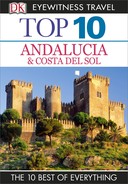Ronda
This is the most famous of the pueblos blancos (white towns) – a scattering of evocative hamlets that reveal their Moorish roots between Málaga, Algeciras and Seville. Ronda is in the southwest corner of this zone and the only town in the wildly mountainous region of the Serranía de Ronda. Located just half an hour’s drive from the Costa del Sol, Ronda hosts up to 75,000 tourists per day, yet has managed to retain its timelessness and charm, despite the inevitable modernization of recent decades. Its natural setting is so spectacular that the views alone make it a must-see experience.![]() www.turismoderonda.es
www.turismoderonda.es
1. El Tajo & Puente Nuevo
Ronda perches upon a sheer outcrop that is split by a precipitous cleft, El Tajo, 100 m (330 ft) deep. The spectacular 18th-century Puente Nuevo bridge links the old city, La Ciudad, with the commercial district.
2. Casa del Rey Moro
A visit to the gardens of this 18th-century mansion, built on the foundations of a Moorish palace, will provide wonderful views.![]() Casa del Rey Moro • C/Santo Domingo 9 • 952 16 93 11 • Open (gardens only) 10am–7pm daily
• Adm €4.00
Casa del Rey Moro • C/Santo Domingo 9 • 952 16 93 11 • Open (gardens only) 10am–7pm daily
• Adm €4.00
3. Palacio del Marques de Salvatierra
This 18th-century mansion is closed to the public, but its façade sports a carved stone portal. The upper section features four squat figures that may represent South American Indians.
4. Puente Viejo & Puente de San Miguel
The Puente Viejo (Old Bridge) dates from 1616 and is thought to be a rebuilding of a Roman span, though some say its pedigree is Moorish, like the Puente de San Miguel. Both cross the gorge at the upstream end of the Río Guadalevín.
5. Banos Arabes
These wonderfully preserved Moorish baths date from the 1200s or early 1300s. The multiple barrel vaulting pierced with star-shaped lunettes is typical of such structures, but the beautifully designed octagonal brick columns supporting horseshoe arches are highly original.![]() Baños Árabes • Barrio de Padre Jesús • 656 95 09 37 • Open 10am–7pm Mon–Fri (to 10pm Fri), 10am–3pm & 7–10pm Sat, 10am–3pm Sun • Adm €3.00
Baños Árabes • Barrio de Padre Jesús • 656 95 09 37 • Open 10am–7pm Mon–Fri (to 10pm Fri), 10am–3pm & 7–10pm Sat, 10am–3pm Sun • Adm €3.00
6. Minarete de San Sebastian
This graceful 14th-century tower is all that remains of a Nasrid mosque.
7. Museo del Bandolero
For some 1,000 years, the Sierras were the haunt of bands of rebels and outlaws. The museum chronicles the history of such notorious brigands.![]() Museo del Bandolero • C/Armiñán 65 • 952 87 77 85 • Open daily. Spring/summer: 10:30am–8:30pm; autumn/winter: 10:45am–7pm • Adm €3.75
Museo del Bandolero • C/Armiñán 65 • 952 87 77 85 • Open daily. Spring/summer: 10:30am–8:30pm; autumn/winter: 10:45am–7pm • Adm €3.75
8. Iglesia de Santa Maria la Mayor
Much of this church incorporates a 13th-century mosque, notably the base of the Mudéjar belfry.![]() Iglesia de Santa María la Mayor • Plaza Duquesa de Parcent • 952 87 40 48 • Open 10am–8pm daily (Nov–Mar: to 6pm); Closed 12:30–2:30pm Sun • Adm €4.00
Iglesia de Santa María la Mayor • Plaza Duquesa de Parcent • 952 87 40 48 • Open 10am–8pm daily (Nov–Mar: to 6pm); Closed 12:30–2:30pm Sun • Adm €4.00
9. Palacio de Mondragon
One of Ronda’s most beautiful palaces dates from 1314. Some of the original polychrome mosaic work and a magnificent Mudéjar ceiling can still be seen, but the rest was altered by the Christian overlords. Part of the palace is now the city’s archaeological museum.![]() Palacio de Mondragón • Plaza de Mondragón • 952 87 08 18 • Open Mar–Oct: 10am–7pm Mon–Fri (to 10pm Fri), 10am–3pm & 7–10pm Sat, 10am–3pm Sun • Adm €3.00
Palacio de Mondragón • Plaza de Mondragón • 952 87 08 18 • Open Mar–Oct: 10am–7pm Mon–Fri (to 10pm Fri), 10am–3pm & 7–10pm Sat, 10am–3pm Sun • Adm €3.00
10. Plaza de Toros
Inaugurated in 1785, Ronda’s bullring was constructed in limestone in an elegant double-tiered sweep; it is the widest in the world and one of the oldest in Spain. Since Ronda is the birthplace of the sport, this is the spiritual home of the tradition. It also houses a museum about the bullfight.![]() Plaza de Toros • C/Virgen de la Paz 15 • 952 87 41 32 • www.rmcr.org • Open 10am–8pm daily (to 7pm Mar & Oct; to 6pm Nov–Mar) • Adm €6.50
Plaza de Toros • C/Virgen de la Paz 15 • 952 87 41 32 • www.rmcr.org • Open 10am–8pm daily (to 7pm Mar & Oct; to 6pm Nov–Mar) • Adm €6.50
The Origins of Bullfighting
The establishment here of the Real Maestranza de Caballería (Royal Academy of Knights) in 1572 set the stage for the birth of bullfighting as we know it. The Maestranza’s role was equestrian training of Spain’s aristocracy and students would challenge wild bulls on horseback. Legend relates that when one rider fell from his horse and was attacked by a bull, a bystander distracted the animal by waving his hat. The man’s grandson Pedro Romero (1754–1839) perfected the Ronda School of bullfighting. Ronda stages only a few fights a year, but they are the most prestigious.
